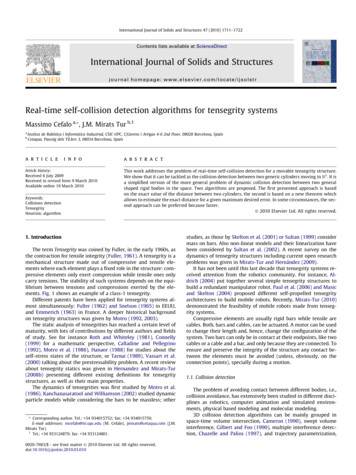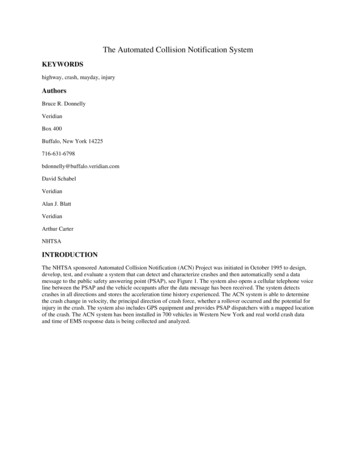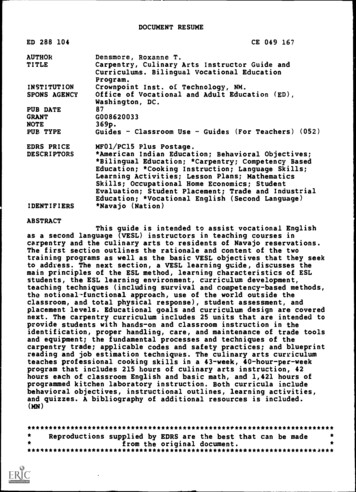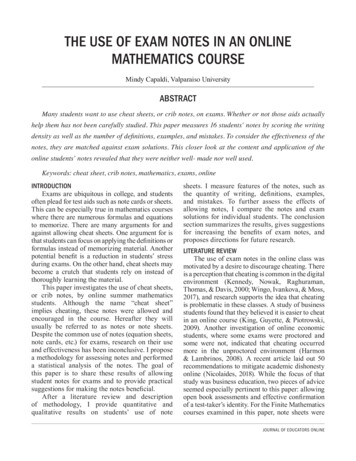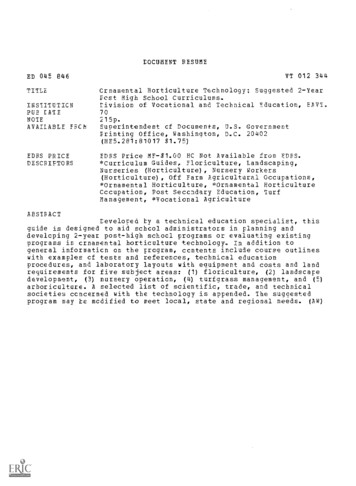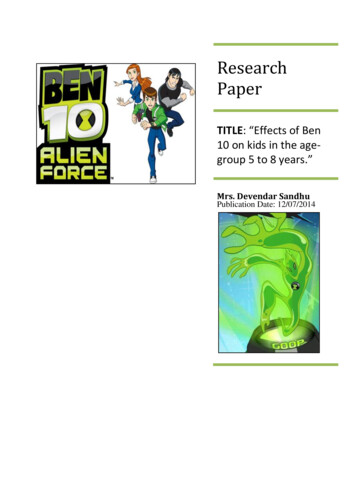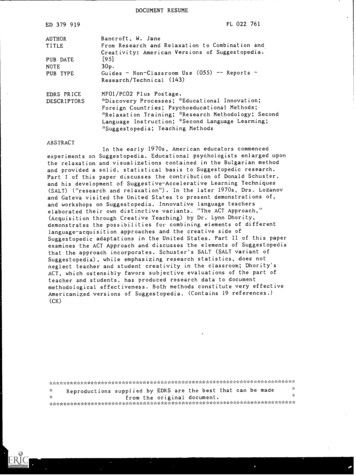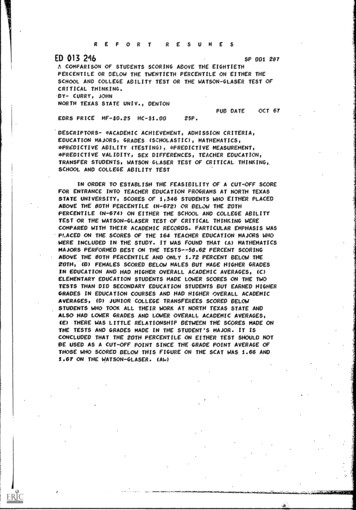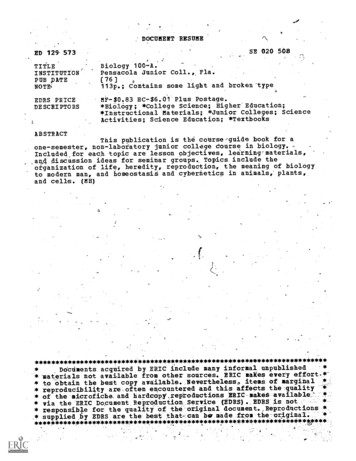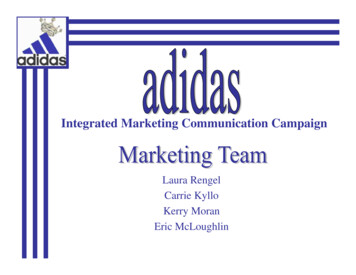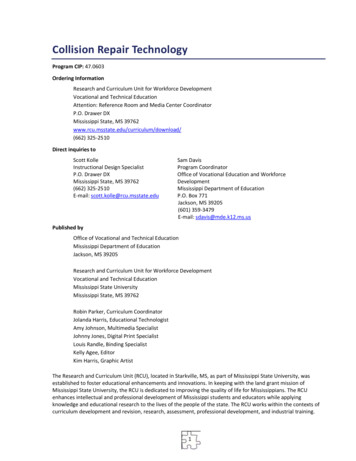
Transcription
Collision Repair TechnologyProgram CIP: 47.0603Ordering InformationResearch and Curriculum Unit for Workforce DevelopmentVocational and Technical EducationAttention: Reference Room and Media Center CoordinatorP.O. Drawer DXMississippi State, MS 39762www.rcu.msstate.edu/curriculum/download/(662) 325-2510Direct inquiries toScott KolleInstructional Design SpecialistP.O. Drawer DXMississippi State, MS 39762(662) 325-2510E-mail: scott.kolle@rcu.msstate.eduSam DavisProgram CoordinatorOffice of Vocational Education and WorkforceDevelopmentMississippi Department of EducationP.O. Box 771Jackson, MS 39205(601) 359-3479E-mail: sdavis@mde.k12.ms.usPublished byOffice of Vocational and Technical EducationMississippi Department of EducationJackson, MS 39205Research and Curriculum Unit for Workforce DevelopmentVocational and Technical EducationMississippi State UniversityMississippi State, MS 39762Robin Parker, Curriculum CoordinatorJolanda Harris, Educational TechnologistAmy Johnson, Multimedia SpecialistJohnny Jones, Digital Print SpecialistLouis Randle, Binding SpecialistKelly Agee, EditorKim Harris, Graphic ArtistThe Research and Curriculum Unit (RCU), located in Starkville, MS, as part of Mississippi State University, wasestablished to foster educational enhancements and innovations. In keeping with the land grant mission ofMississippi State University, the RCU is dedicated to improving the quality of life for Mississippians. The RCUenhances intellectual and professional development of Mississippi students and educators while applyingknowledge and educational research to the lives of the people of the state. The RCU works within the contexts ofcurriculum development and revision, research, assessment, professional development, and industrial training.1
Table of ContentsAcknowledgements . 3Preface . 5Executive Summary . 7Research Synopsis. 13Blueprint . 17Collision Repair . 19Unit 1: Fundamentals of Collision Repair . 19Unit 2: Fundamentals of Collision Repair (Mechanical and Electrical Components) . 44Unit 3: Fundamentals of Collision Repair (Basic Non – Structural Analysis and Damage Repair) . 65Unit4: Fundamentals of Collision Repair (Basic Structural Analysis and Damage Repair) . 80Unit 5: Intermediate Painting and Refinishing. 96Unit 6: Safety (Review), Employability Skills, and Business Skills . 114Unit 7: Advanced Non – Structural Analysis and Damage Repair . 130Unit 8: Advanced Structural Analysis and Damage Repair . 143Unit 9: Advanced Painting and Refinishing . 159Student Competency Profile . 172Appendix A: 21st Century Skills Standards . 174Appendix B: MS Academic Standards . 175Appendix C: ACT College Readiness Standards . 178Appendix D: National Industry Standards. 189Appendix E: National Educational Technology Standards for Students . 1902
AcknowledgmentsThe Collision Repair Technology curriculum was presented to the Mississippi Board of Education on January 16,2009. The following persons were serving on the state board at the time:Dr. Hank M. Bounds, Executive SecretaryMr. Claude Hartley, ChairMr. William Harold Jones, Vice ChairMr. Howell “Hal” N. GageDr. O. Wayne GannMs. Rebecca HarrisMr. Charles McClellandMs. Sondra Parker CaillavetMs. Rosetta RichardsDr. David SistrunkMike Mulvihill, Interim Associate State Superintendent of Education for the Office of Vocational Education andWorkforce Development, at the Mississippi Department of Education assembled an oversight committee toprovide input throughout the development of the Collision Repair Technology Curriculum Framework andSupporting Materials. Members of this task force were as follows:Dean Batton, Simpson County Vocational CenterAnnie Covington, Coffeeville Public SchoolsLinda Davis, Millsaps Vocational CenterDave Ellison, Hinds Community CollegeJimmy Flynt, Empire TrucksScott Kolle, Research and Curriculum UnitRick McDonald, Mississippi Gulf Coast Community CollegeTed Mangum, Jones County Vocational CenterMichael Myrick, Canton Career CenterTommy Nance, Fowler BuickRay Orr, Itawamba Community CollegeDanny Owen, Tupelo Public SchoolsBen Pratt, Northeast Mississippi Community CollegeRick Saucier, Hancock County Vo-Tech CenterChad Smith, Smith Brothers Collision RepairDale Smith, Thomson MachineryCravin Turnage, Holly Springs Public SchoolsEarl White, Mississippi Department of EducationAlso, a special thanks is extended to the teachers who contributed teaching and assessment materials that areincluded in the framework and supporting materials. Members who contributed were as follows:Wade Jackson, Oakley Training School, Raymond, MSSheddrick Lewis, Amite County School District, Liberty, MSJames Terrell, Oakley Training School, Raymond, MSAppreciation is expressed to the following staff members at the Mississippi Department of Education whoprovided guidance and insight throughout the development process:3
Sam Davis, Program Coordinator and Division Director, Office of Vocational Education and WorkforceDevelopment, Mississippi Department of Education, Jackson, MSBill McGrew, Division Director of Instructional Programs and Student Organizations, Office of VocationalEducation and Workforce Development, Mississippi Department of EducationChris Wall, Bureau Director of Instructional Programs and Student Organizations, Office of VocationalEducation and Workforce Development, Mississippi Department of EducationFinally, standards in the Collision Repair Technology Curriculum Framework and Supporting Materials are based onthe following:Industry StandardsNATEF was founded in 1983 as an independent, non-profit organization with a single mission: To evaluatetechnician training programs against standards developed by the automotive industry and recommendqualifying programs for certification (accreditation) by ASE, the National Institute for Automotive ServiceExcellence. For more information, visit http://www.natef.org/. Reprinted with permission.I-CAR was formed in 1979 as a not-for-profit collision training organization. Its focus is on activities andresources that assist the collision repair industry achieve a high level of training for its technicians, andcontent is based on National Automotive Technicians Education Foundation (NATEF) standards. I-CARtechnical training programs are developed and delivered to technicians in the collision industry. For moreinformation, visit http://www.i-car.com/.Applied Academic Credit BenchmarksMississippi Department of Education 2007 Mississippi Mathematics Framework Revised21st Century Skills and Information and Communication Technologies Literacy StandardsIn defining 21st century learning, the Partnership for 21st Century Skills has embraced five content andskill areas that represent the essential knowledge for the 21st century: Global awareness; civicengagement; financial, economic, and business literacy; learning skills that encompass problem-solving,critical-thinking, and self-directional skills; and Information and Communication Technology (ICT) literacy.National Educational Technology Standards for StudentsReprinted with permission from National Educational Technology Standards for Students: ConnectingCurriculum and Technology, Copyright 2007, ISTE (International Society for Technology in Education),(800) 336-5191 (U.S. and Canada) or (541) 302-3777 (International), iste@iste.org, www.iste.org. All rightsreserved. Permission does not constitute an endorsement by ISTE.ACT College Readiness StandardsThe College Readiness Standards are sets of statements intended to helpstudents understand what is expected of them in preparation for the ACT. Thesestandards are integrated into teaching and assessment strategies throughout thecurriculum framework.4
PrefaceSecondary vocational–technical education programs in Mississippi are faced with many challenges resulting fromsweeping educational reforms at the national and state levels. Schools and teachers are increasingly being heldaccountable for providing true learning activities to every student in the classroom. This accountability is measuredthrough increased requirements for mastery and attainment of competency as documented through bothformative and summative assessments.The courses in this document reflect the statutory requirements as found in Section 37-3-49, Mississippi Code of1972, as amended (Section 37-3-46). In addition, this curriculum reflects guidelines imposed by federal and statemandates (Laws, 1988, ch. 487, §14; Laws, 1991, ch. 423, §1; Laws, 1992, ch. 519, §4 eff. from and after July 1,1992; Carl D. Perkins Vocational Education Act IV, 2007; and No Child Left Behind Act of 2001).5
Using This DocumentUnit Number and TitleSuggested Time on TaskAn estimated number of clock hours of instruction that should be required to teach the competencies andobjectives of the unit. A minimum of 140 hours of instruction is required for each Carnegie unit credit. Thecurriculum framework should account for approximately 75–80% of the time in the course.Competencies and Suggested ObjectivesA competency represents a general concept or performance that students are expected to master as arequirement for satisfactorily completing a unit. Students will be expected to receive instruction on allcompetencies. The suggested objectives represent the enabling and supporting knowledge and performances thatwill indicate mastery of the competency at the course level.Suggested Teaching StrategiesThis section of each unit indicates research-based strategies that can be used to enable students to master eachcompetency. Emphasis has been placed on strategies that reflect active learning methodologies. Teachers shouldfeel free to modify or enhance these suggestions based on needs of their students and resources available in orderto provide optimum learning experiences for their students.Suggested Assessment StrategiesThis section indicates research-based strategies that can be used to measure student mastery. Examples ofsuggested strategies could include rubrics, class participation, reflection, and journaling. Again, teachers shouldfeel free to modify or enhance these suggested assessment strategies based on local needs and resources.Integrated Academic Topics, 21st Century Skills and Information and Communication Technology LiteracyStandards, ACT College Readiness Standards, and Technology Standards for StudentsThis section identifies related academic topics as required in the Subject Area Testing Program (SATP) in Algebra I,Biology I, English II, and U.S. History from 1877, which are integrated into the content of the unit. Research-basedteaching strategies also incorporate ACT College Readiness standards. This section also identifies the 21st CenturySkills and Information and Communication Technology Literacy skills. In addition, national technology standards forstudents associated with the competencies and suggested objectives for the unit are also identified.ReferencesA list of suggested references is provided for each unit. The list includes some of the primary instructionalresources that may be used to teach the competencies and suggested objectives. Again, these resources aresuggested, and the list may be modified or enhanced based on needs and abilities of students and on availableresources.6
Executive SummaryProgram DescriptionCollision Repair is a pathway for students in the Transportation career cluster. The following descriptionis from the current Standard Course of Study for Career–Technical Education, Mississippi Department ofEducation. Collision Repair is a hands-on program that will prepare students for employment orcontinuing education in the collision repair industry. The content is based on industry content. Thecontent consists of fundamentals; mechanical/electrical components; nonstruc
Scott Kolle Sam Davis Instructional Design Specialist Program Coordinator P.O. Drawer DX Office of Vocational Education and Workforce Mississippi State, MS 39762 Development (662) 325-2510 Mississippi Department of Education E-mail: scott.kolle@rcu.msstate.edu P.O. Box 771 Jackson, MS 39205 (601) 359-3479 E-mail: sdavis@mde.k12.ms.us Published by Office of Vocational and
